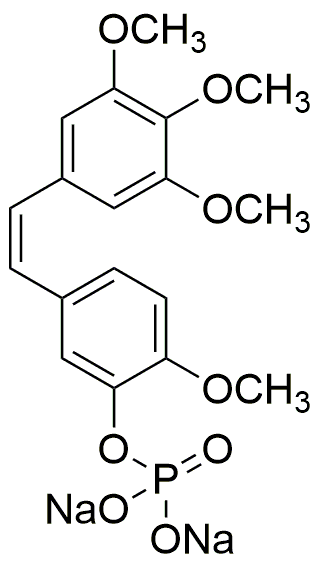Combretastatin A4 phosphate disodium salt is widely utilized in research focused on:
- Cancer Treatment: This compound is being studied for its ability to inhibit tumor growth by disrupting the blood supply to tumors, making it a promising candidate for cancer therapies.
- Drug Development: Researchers are exploring its potential as a lead compound in the development of new anti-cancer drugs, particularly due to its unique mechanism of action compared to traditional chemotherapy agents.
- Targeted Therapy: Its specificity for tumor vasculature allows for targeted treatment options, reducing side effects commonly associated with non-targeted therapies.
- Combination Therapy: It is being evaluated in combination with other chemotherapeutic agents to enhance efficacy and overcome drug resistance in various cancer types.
- Preclinical Studies: The compound is frequently used in preclinical models to assess its pharmacokinetics and pharmacodynamics, providing valuable insights for future clinical trials.
Información general
Propiedades
Seguridad y normativas
Aplicaciones
Combretastatin A4 phosphate disodium salt is widely utilized in research focused on:
- Cancer Treatment: This compound is being studied for its ability to inhibit tumor growth by disrupting the blood supply to tumors, making it a promising candidate for cancer therapies.
- Drug Development: Researchers are exploring its potential as a lead compound in the development of new anti-cancer drugs, particularly due to its unique mechanism of action compared to traditional chemotherapy agents.
- Targeted Therapy: Its specificity for tumor vasculature allows for targeted treatment options, reducing side effects commonly associated with non-targeted therapies.
- Combination Therapy: It is being evaluated in combination with other chemotherapeutic agents to enhance efficacy and overcome drug resistance in various cancer types.
- Preclinical Studies: The compound is frequently used in preclinical models to assess its pharmacokinetics and pharmacodynamics, providing valuable insights for future clinical trials.
Documentos
Hojas de datos de seguridad (HDS)
La SDS proporciona información de seguridad completa sobre la manipulación, el almacenamiento y la eliminación del producto.
Especificación del producto (PS)
La PS proporciona un desglose completo de las propiedades del producto, incluida la composición química, el estado físico, la pureza y los requisitos de almacenamiento. También detalla los rangos de calidad aceptables y las aplicaciones previstas del producto.
Certificados de análisis (COA)
Busque certificados de análisis (COA) ingresando el número de lote del producto. Los números de lote y de partida se pueden encontrar en la etiqueta de un producto después de las palabras "Lote" o "Lote".
Número de catálogo
Número de lote/lote
Certificados de origen (COO)
Este certificado de origen confirma el país en el que se fabricó el producto y también detalla los materiales y componentes utilizados en él y si se deriva de fuentes naturales, sintéticas u otras fuentes específicas. Este certificado puede ser necesario para cumplir con las normativas aduaneras, comerciales y regulatorias.
Número de catálogo
Número de lote/lote
Hojas de datos de seguridad (HDS)
La SDS proporciona información de seguridad completa sobre la manipulación, el almacenamiento y la eliminación del producto.
DownloadEspecificación del producto (PS)
La PS proporciona un desglose completo de las propiedades del producto, incluida la composición química, el estado físico, la pureza y los requisitos de almacenamiento. También detalla los rangos de calidad aceptables y las aplicaciones previstas del producto.
DownloadCertificados de análisis (COA)
Busque certificados de análisis (COA) ingresando el número de lote del producto. Los números de lote y de partida se pueden encontrar en la etiqueta de un producto después de las palabras "Lote" o "Lote".
Número de catálogo
Número de lote/lote
Certificados de origen (COO)
Este certificado de origen confirma el país en el que se fabricó el producto y también detalla los materiales y componentes utilizados en él y si se deriva de fuentes naturales, sintéticas u otras fuentes específicas. Este certificado puede ser necesario para cumplir con las normativas aduaneras, comerciales y regulatorias.


